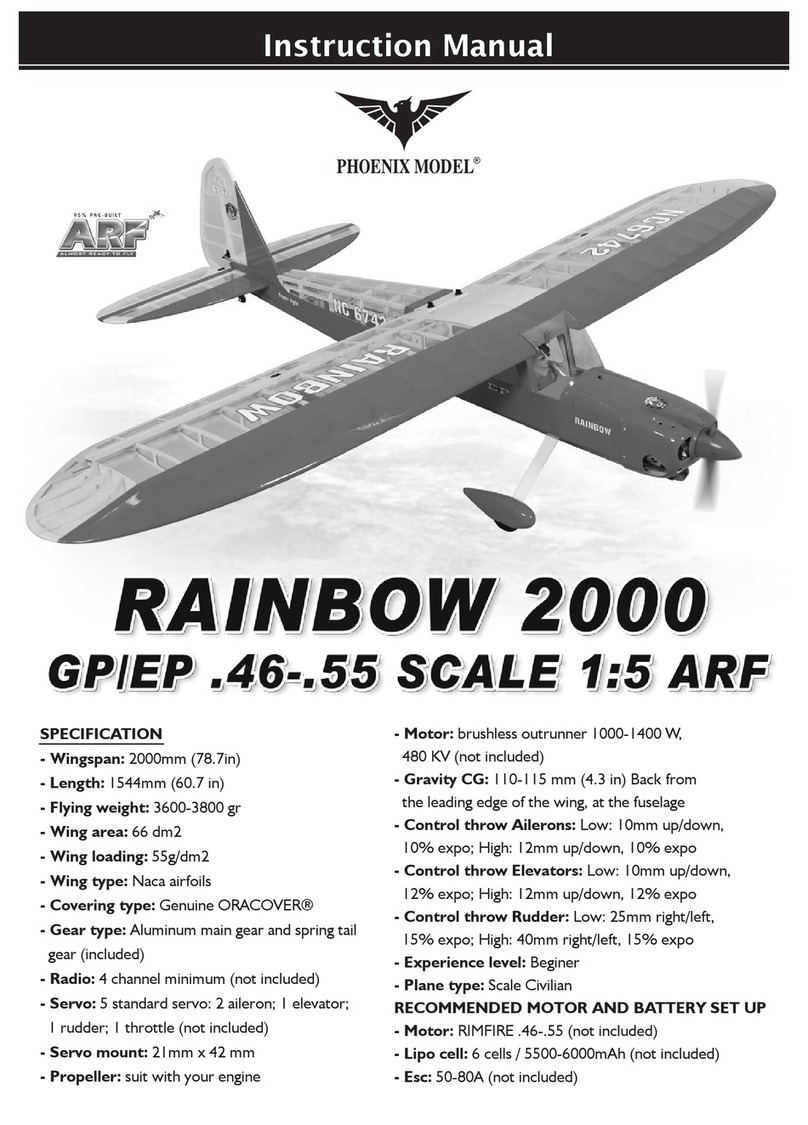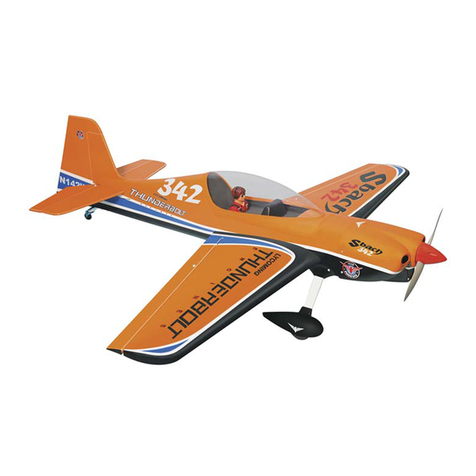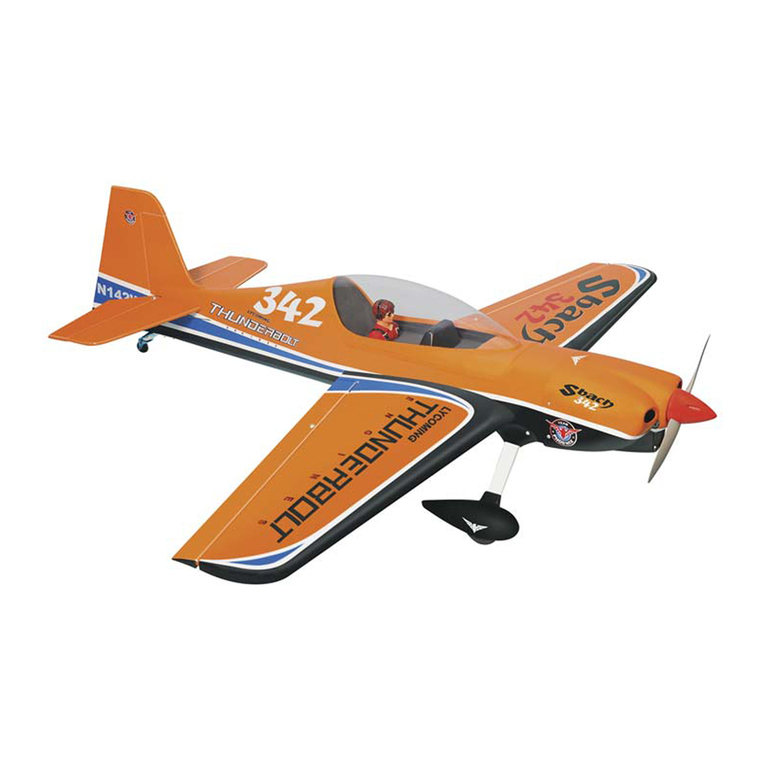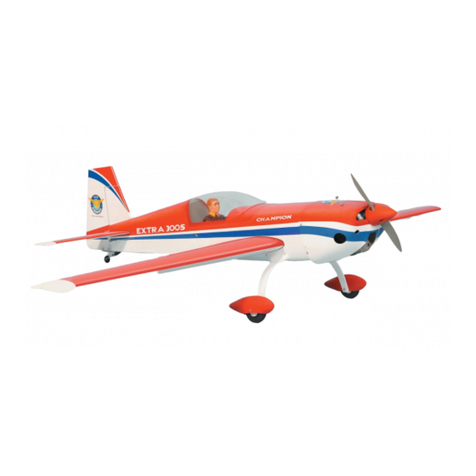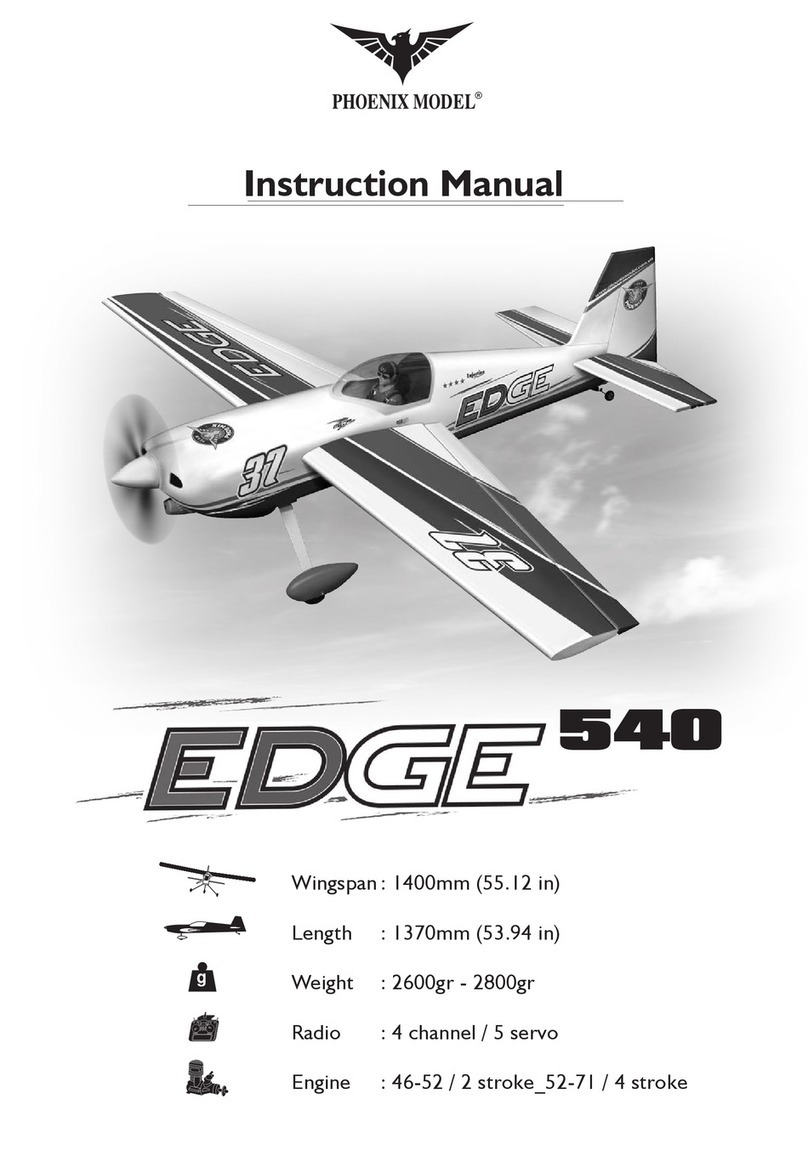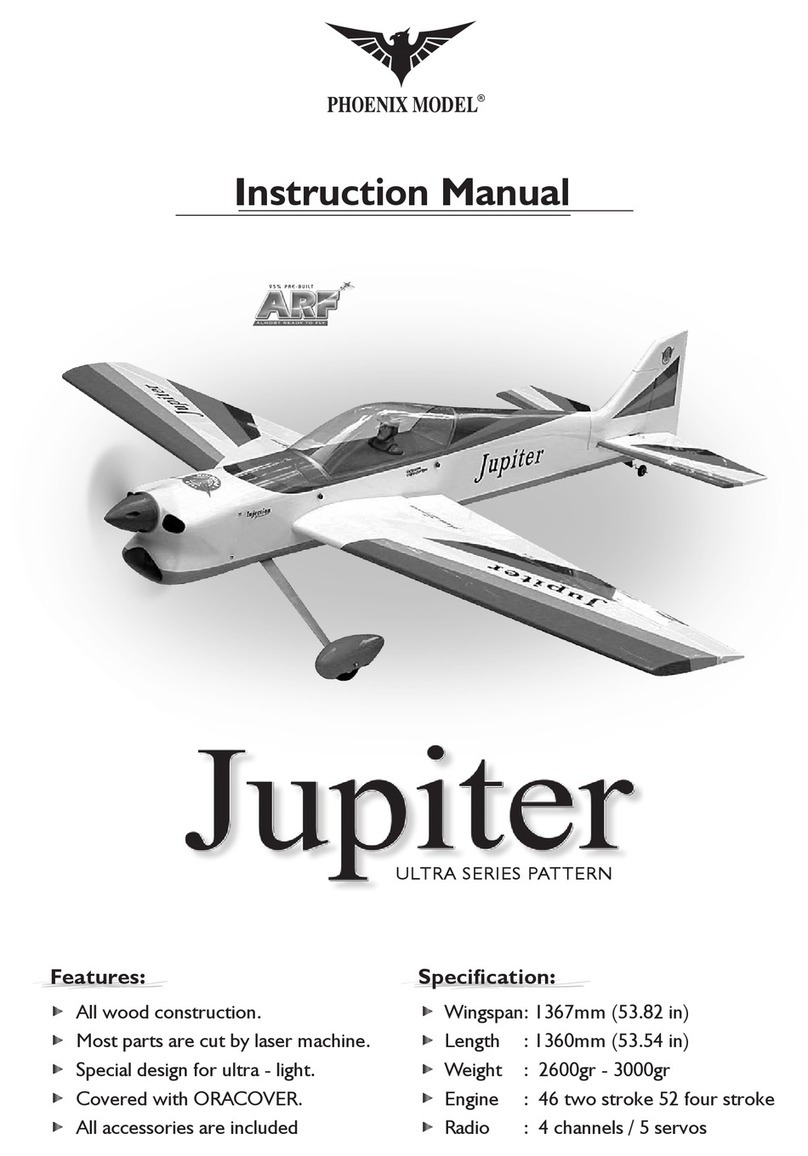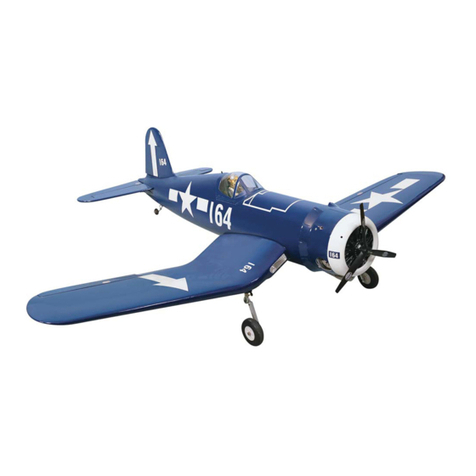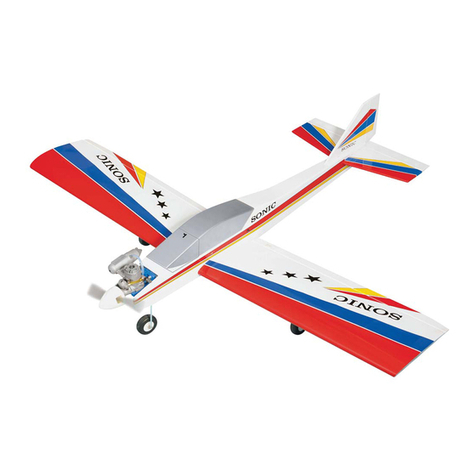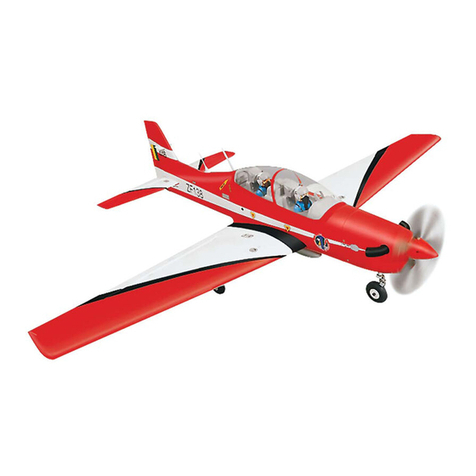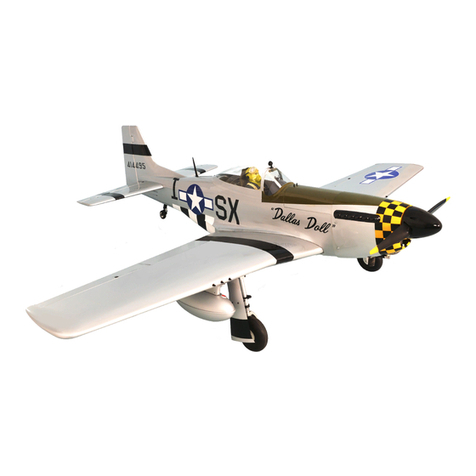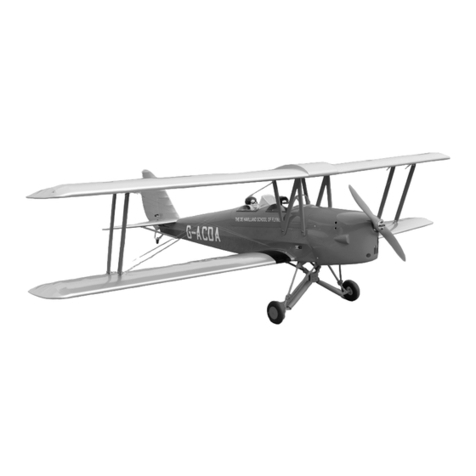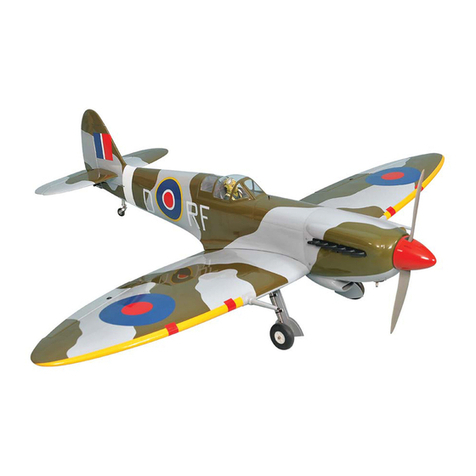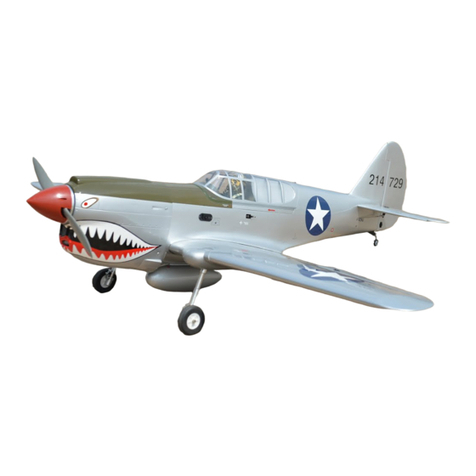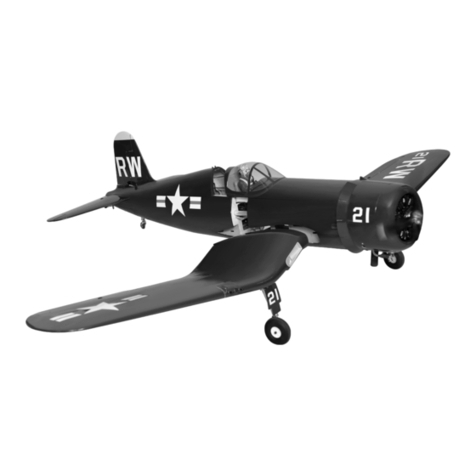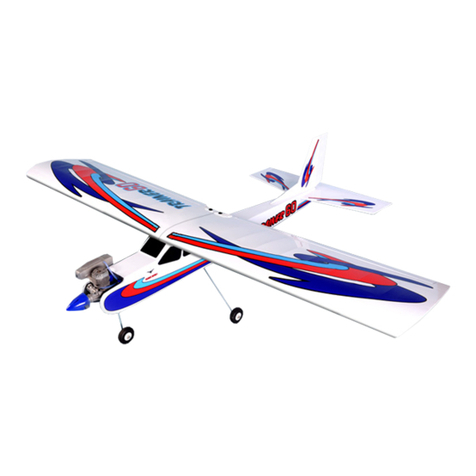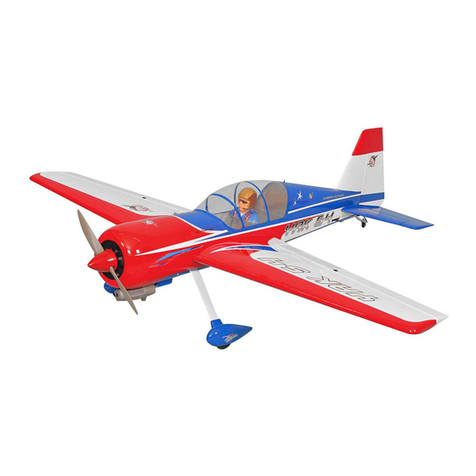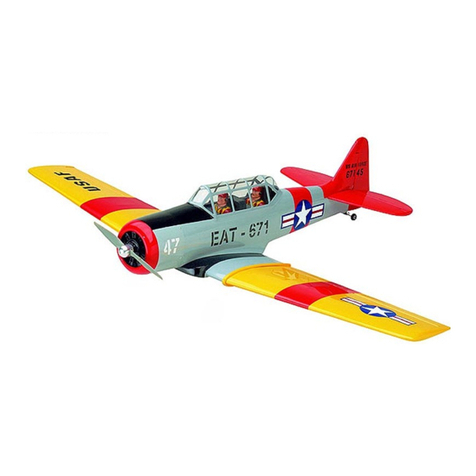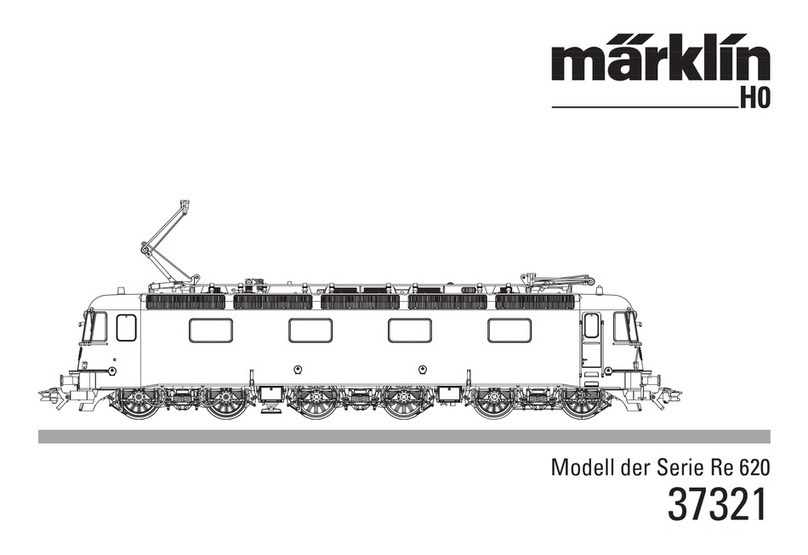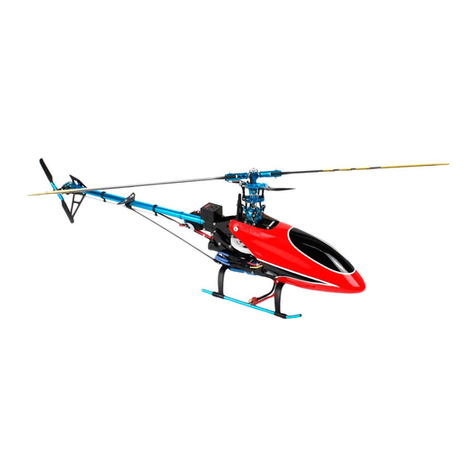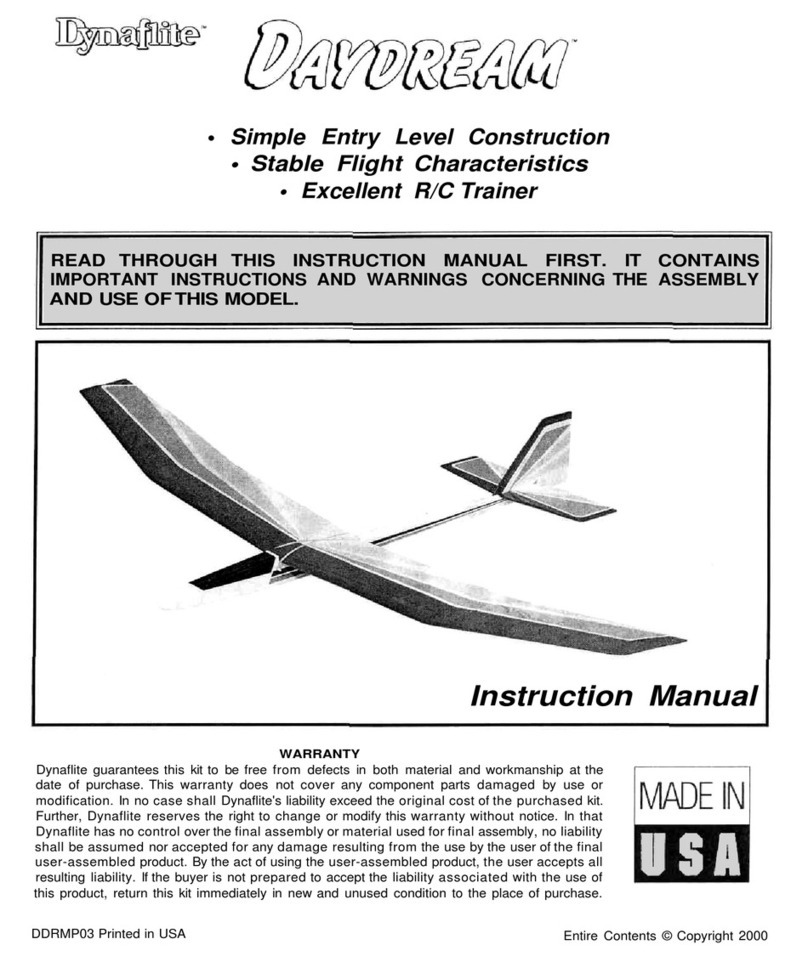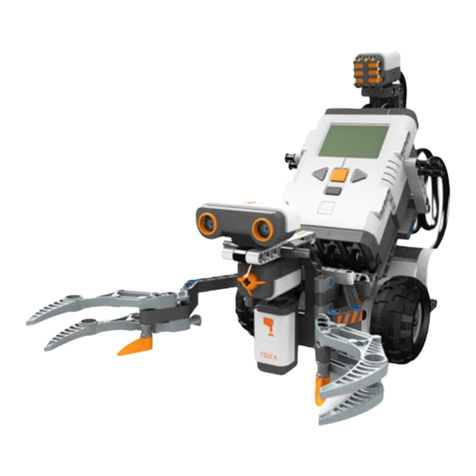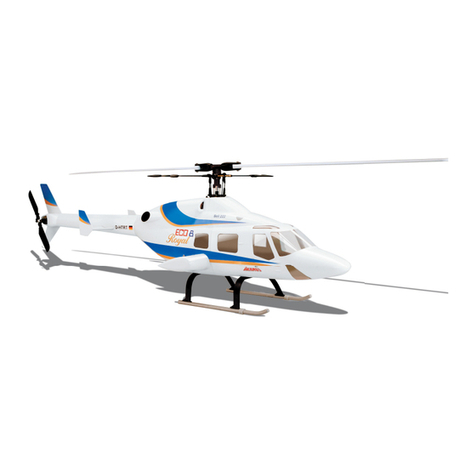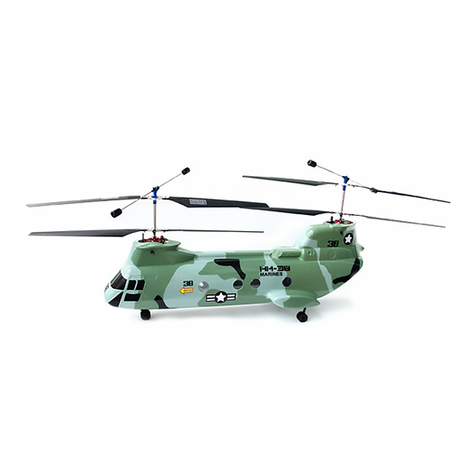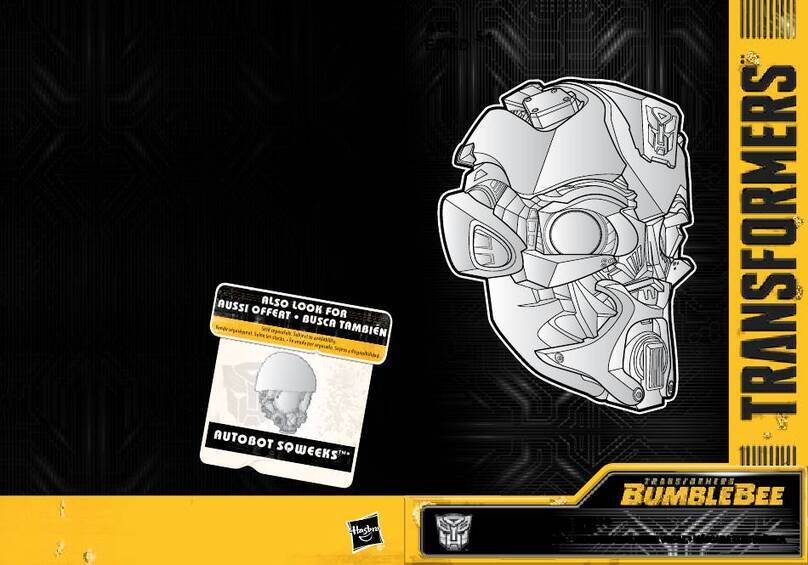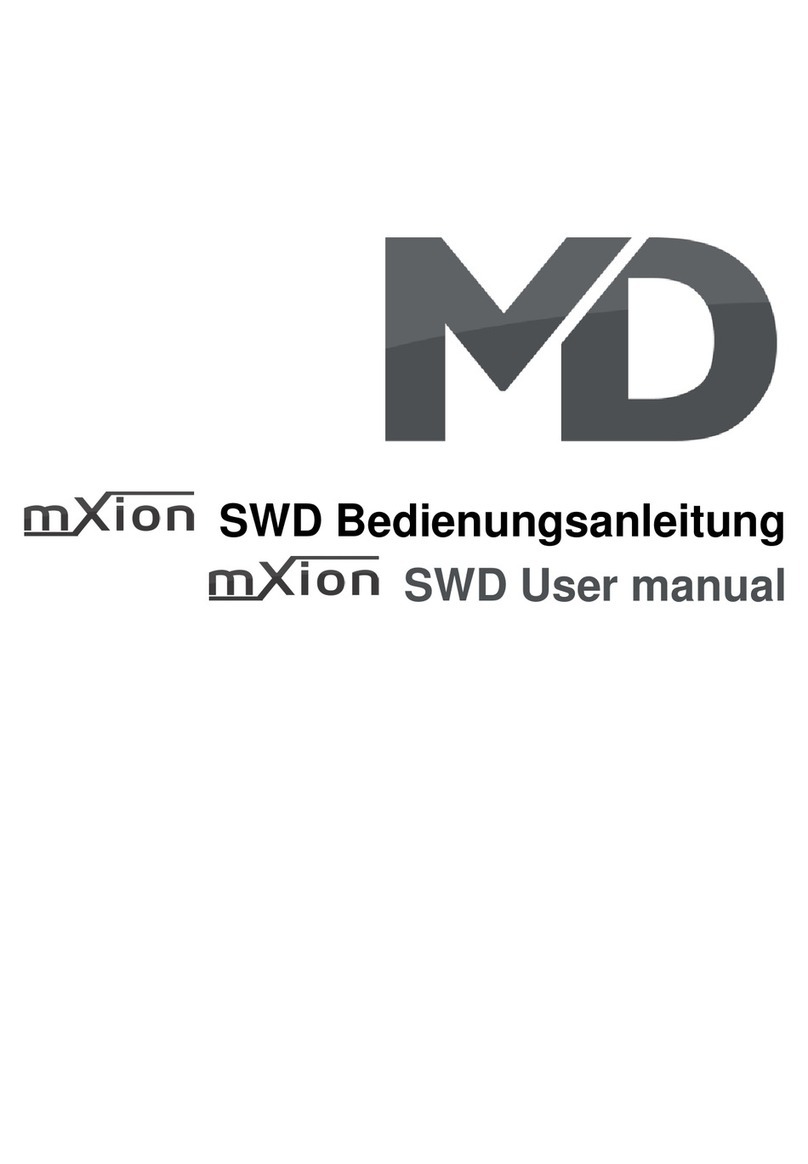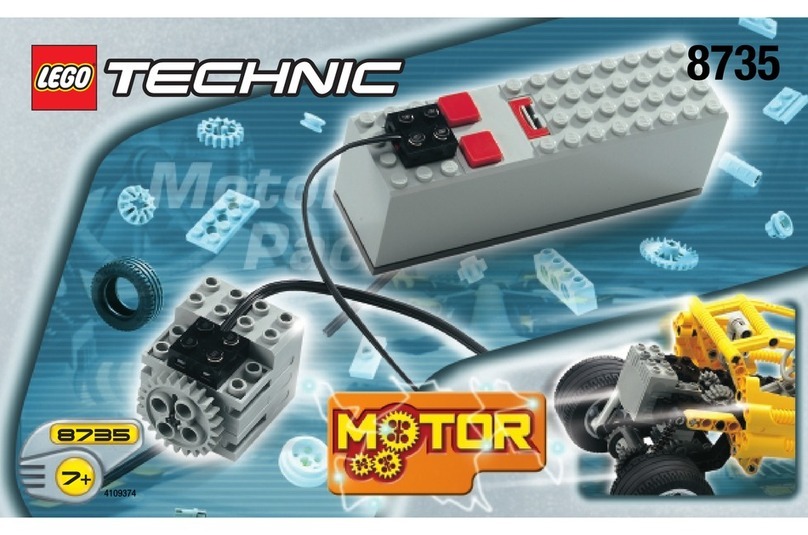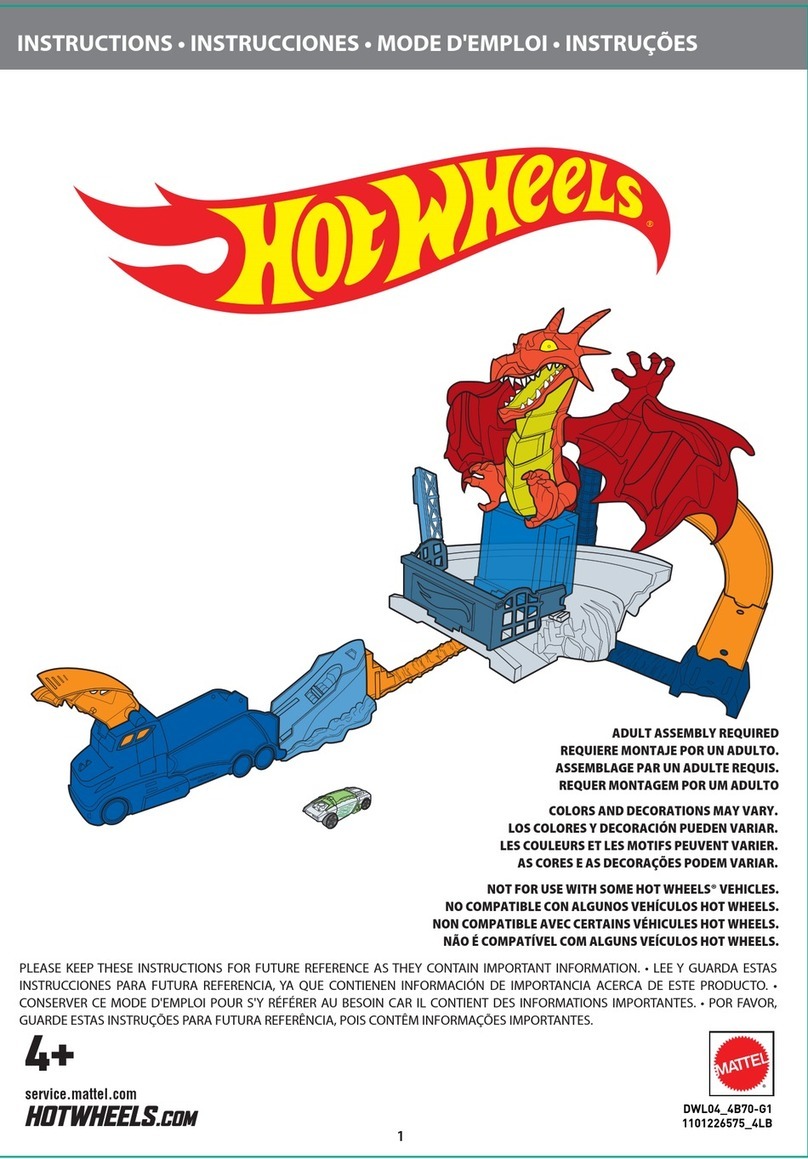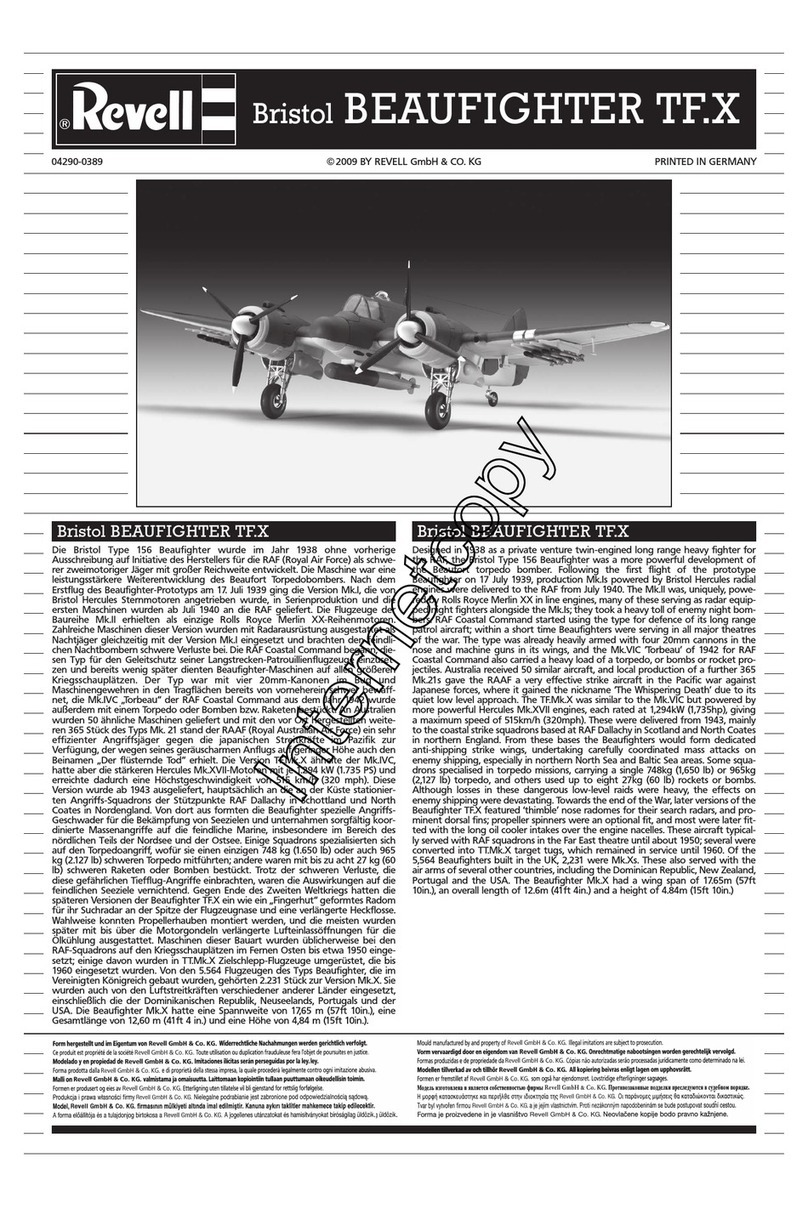INTRODUCTION
Thank you for choosing the new Scanner ARF by Phoenix Model. The Scanner was designed from the
ground up with the intermediate sport flyer in mind. It is a low wing sport aerobatic aircraft that is easy to fly
and quick to assemble, yet is capable of aerobatics to please even the best sport pilot. The airframe is
conventionally built using balsa, plywood and veneer to make it stronger than the average ARF kit, yet the
design allows the aircraft to be built light as well. You will find that most of the work has been done for you
already. The pushrods are premade to the correct lengths, the motor mount has been installed and even the
hinges are preinstalled and pinned for security. Flying the Scanner is simply a joy too. It's constant cord
wings make landing a breeze without the bad habits of other aerobatic planes and it's generous stabilizer
area keeps it tracking straight and true.
The Scanner ARF is an easy flying sport airplane, however, it may not be appropriate for some first time
modelers. If you have chosen the Scanner ARF as your first airplane, we recommend you seek assistance
from an experienced modeler.
We know you'll enjoy flying the ScannerARF as much as we have enjoyed designing it for you. We
encourage you to let us know about your successes. Fill out the consumer feedback survey at the end of
the manual, send us a letter or contact us on the Internet. Again, thank you for purchasing the Scanner ARF
by Phoenix Model.
ADDITIONAL ITEMS REQUIRED
о40-53 Two Stroke Engine
о4 Channel Radio With 4 Servos
оGlow Plug to Suit Engine
оPropeller to suit Engine
оDubro Protective Foam Rubber
оGlobal Silicon Fuel Line
оPrather Stick On Weight For Balance
TOOLS AND SUPPLIES NEEDED
оKwik Bond #2 Thick C/AGlue
оKwik Bond 30 Minute Epoxy
оKwik Bond 5 Minute Epoxy
оHand or Electric Drill
оAssorted Drill Bits
оModeling Knife
оStraight Edge Ruler
о2mm Bondhus Ball Driver # 10654
1
Instruction Manual Scanner
26
14) Insert the nosegear pushrod wire through the
adjustable servo connector on the rudder servo
arm. Hold the nose gear assembly in the neutral
position and tighten the set screw in the servo
connector. Roll the airplane on the ground to
ensure it rolls straight. If not, adjust the pushrod
wire. When satisfied, cut off the excess wire.
15) Glue the second of the two 1/2'' *1/2''*1/4''
pieces of wood between the fuselage side and
the steering pushrod housing to help hold the
housing in place and prevent it from flexing. Use
the same technique as with the throttle. See
photo # 20 above.
16) With the elevator in neutral, mark where the
pushrod wire crosses the servo arm. Place a
Z-bend in the wire at the mark made. Attach the
servo arm to the wire and cut off the excess wire.
17) Repeat step # 16 for the rudder pushrod.
Notice the position of the servo arm on the
servo. See photo # 21 below.
8) Connect the servo to your radio's receiver and
turn on the system. Set the trim tabs on the
transmitter to neutral and center the servo arms.
The elevator and rudder servo arms should be
perpendicular to the servos. For the throttle, we
suggest setting the throttle trim tab and the
throttle stick to the lowest setting which will be
used to shut off the engine.Also mount the servo
arm about 450back from perpendicular. See
photo # 7 below.
9) One at a time, hold the pushrods in position
over the respective servo to check for proper
servo direction. If any servo turns in the wrong
direction, switch your radio's reversing switches
as necessary to achieve the correct direction.
10) Slide the throttle pushrod wire through the
adjustable servo connector on the throttle servo
arm. Pull the carburator barrel to the fully closed
position. Tighten the set screw in the connector.
11) Move the throttle stick and trim tab to the full
throttle position. The carburetor barrel should be
opened fully. If it is not, move the adjustable
servo connector on the servo arm out one hole.
If the servo moves too far, and the pushrod
binds, move the adjustable servo connector in
one hole on the servo arm. You should adjust
the linkage so full forward stick and trim should
be idle. Full back stick and full back trim should
close the carburetor barrel, which in use will stop
the engine.
12) When satisfied with the pushrod assembly
cut off the excess wire and permanently attach
the adjustable servo connector to the servo arm.
13) Glue one of the 1/2'' *1/2''*1/4'' pieces of
wood between the fuselage side and the throttle
pushrod housing to help hold the housing in
place and prevent it from flexing. See photo #
20 below.
FIGURE #7
FRONT
Throttle pushrod Elevator pushrod
Rudder
pushrod
27
Throttle pushrod
28
11
Instruction Manual Scanner
2
Instruction Manual Scanner
3
Instruction Manual Scanner
4
Instruction Manual Scanner
2) Test fit the dihedral brace into each wing half.
The brace should slide in easily up to the
centerline you drew. If it does not, use 220 grit
sandpaper with a sanding block and sand down
the edges and ends of the brace until the proper
fit is obtained.
*Note* the dihedral brace is cut in the shape of
a "V". This shape gives the wing the correct
dihedral angle. Make sure you don't test fit the
brace upside down.
3) When satisfied with the fit of the dihedral
brace in each wing half, remove the brace .Mix
equal amounts of part A and part B 30 minute
epoxy. Coat all sides of the dihedral brace box
and half of the wing brace with the epoxy. Make
sure to cover the top and bottom as well as the
sides. Use enough epoxy to fill any gaps.
4) Insert the dihedral brace into one wing half up
to the centerline. Wipe off any excess epoxy that
may have squeezed out of the joint using paper
towels. See photo #2 below
11
Make centerline
12
Dihedral brace
6
Instruction Manual Scanner
13
14
5) Once the epoxy has cured, trial fit both wing
halves together.The center gribs should fit flush
together with little or no gaps existing. If gaps do
exist, use 220 Grit sandpaper and sand down
the high spots on the root ribs and the wing
joiner until the proper fit is obtainer. The amount
of dihedral is built into the wings by angling the
root ribs the correct amount. With one wing half
flat on the table, the other wing tip should be
approximately 2" off of the surface of the table. If
this need to be adjusted, you may do so by
sanding small amount from the center ribs or
dihedral brace.
6) To protect the covering from the epoxy used
to glue the wing halves together, carefully apply
masking tape around the edge of the root rip on
the top and bottom of each wing half. See photo
#3 below.
7) Mix a generous amount of 30 minute epoxy.
Coat the exposed half of the dihedral brace, the
wing joiner box and both root ribs with epoxy.
Slide the two wing halves together and carefully
align them at the leading and trailing edges.
Wipe away any excess epoxy using paper
towels. Use masking tape wrapped around the
center section to hold the halves in place until
the epoxy cures. See photo # 4below.
8) When the epoxy has cured, carefully remove
the masking tape from the wing.
9) Peel off the backing from the self adhesive
covering strip used to cover the center section
wing joint seam. Apply the strip to the center
section of the wing on the bottom first, and the
top using the rest of the material.
5
Instruction Manual Scanner
2) Bolt the wing to the fuselage. Set the
horizontal stabilizer onto the stabilizer mounting
platform on the fuselage. To align the horizontal
stabilizer with the wing, use figure #2 and # 3.
when viewed from the rear, the horizontal
stabilizer should be level with the wing. If it is not
level, use sandpaper and sand down the high
side of the stabilizer mounting platform until the
proper alignment is achieved. Measure the
distance form each wing tip to each stabilizer tip.
These distances should be equal. If they are not,
adjust the stabilizer until the measurements are
equal.
5) Remove the horizontal stabilizer. Using the
lines you just drew as a guide, carefully remove
the covering from between them, using a
modeling knife. This is where the horizontal
stabilizer will be glued in place.
6) When you are sure that every thing is aligned
correctly, glue the horizontal stabilizer in place
using 30Minute Epoxy. Double check all of your
measurements once more before the epoxy
cures. Hold the stabilizer in place with T-pins or
masking tape until the epoxy has cured.
7) Slide the vertical stabilizer into the slot in the
mounting platform in the top of the fuselage. Mark
the shape of the fuselage on the left and right
sides of the vertical stabilizer using a felt-tip pen.
8) Now, remove the vertical stabilizer and using a
modeling knife, carefully cut just inside the marked
lines and remove the film on both sides of the
vertical stabilizer. Just as you did with the horizontal
stabilizer, make sure you only press hard enough to
cut the film, not the balsa vertical stabilizer.
3) When you are satisfied with the alignment,
hold the stabilizer in place with T-pins or
masking tape, but do not glue at this time.
4) On the bottom of the horizontal stabilizer,
draw a line where it and the fuselage meet. Do
this on both the right and left sides.
FIGURE # 3
FIGURE # 2
AA-1
A=A-1
A=A-1
AA1
B1
B
90
O
B=B-1
15
Glue with epoxy
7
Instruction Manual Scanner
Horizontal and vertical stabilizer
installation
1) Using your ruler, find the centerline of the
horizontal stabilizer, at the trailing edge, and
place a mark. Use a triangle and extend this
mark, from back to front, across the top and
bottom of the stabilizer. Also place a mark at the
centerline of the fuselage at the front and rear of
the stabilizer mounting area. These mark will be
used to line up the stabilizer to the fuselage. See
photo #9 below.
19
2) There are two hardwood landing gear blocks
with one precut channel in each block in the
bottom of the wing. Locate the two landing gear
blocks on the bottom of the wing and using a
modeling knife, remove the covering from over
the precut channels. See photo #13 below.
2) Remove the muffler from the engine and set
the engine in the mount. Adjust the depth of the
engine in the mount. The front of the thrust
washer should be 5/16'' forward of the front edge
of the fuselage sides. This will allow clearance
for the propeller.
3) Once satisfied with the fit of the engine, mark
the position of the four engine mounting holes
onto the mount. Remove the engine and drill out
the mounting holes using a 7/64'' drill bit. Drill
one hole at a time, checking the alignment after
each hole is drilled.
4) When reinstalling the engine into the motor
mount, connect the carburetor arm to the
preinstalled throttle pushrod. The Z-Bend fits into
the lower hole in the throttle arm. Mount the
engine using the four3*25mm flat head wood
screws. See photo #11 below.
Remove the covering
Glue with epoxy
16
17
18
9) Set the vertical stabilizer back in place. Using
a triangle, check to ensure that it is 900to the
horizontal stabilizer.
10) Once you are sure that everything is aligned
correctly, glue the vertical stabilizer in place
using 30 Minute Epoxy. Double check all of your
measurements once more before the epoxy
cures. Hold the stabilizer in place with T-pins
until the epoxy has cured.
Engine Mounting
1) Test fit your engine into the engine mount.
Because the width of different engines differ, the
motor mount may need to be widened to
accommodate your engine. You can do this by
loosening the motor mount screw and sliding the
mounting beams apart. When satisfied with the
fit , tighten the mounting screws.
5) Mount the muffler to the engine using the
mounting bolts provided with your engine.
Landing Gear Installation
1) Locate the two main landing gear wires, one
nose gear wire, four nylon mounting straps eight
3*12mm Phillips head sheet metal screws, three
wheels, six wheel collars w/set screws, and one
nylon steering arm with set screw. See photo
#12 below.
7) Locate the nose gear wire. Slide the nose
gear wire up through the lower portion of the
nose gear block, then through the nylon steering
arm, then through the upper portion of the nose
gear block. The top of the nose gear wire should
be flush with the top of the nose gear bracket.
See photo # 15 below.
3) Test fit the two main gear wires into the
channels. When satisfied with the fit, secure the
wires in place using the four nylon straps and
eight 3*12mm sheet metal screws. If you look
closely at the wing surface surrounding the
channel for the wire, you will notice that there
are already four pilot holes drilled to
accommodate the screws for the straps. Mount
the straps at these locations. See photo # 14
below.
4) Install two of the wheels onto the axles using
the four wheel collars and set screws provided.
The wheels should be centered on the axles with
a wheel collar on each side, holding them in
place. Tighten the set screws on the collars to
secure them in place.The wheels should rotate
freely. You should apply a small drop of lock-Tite
thread lock to each set screw to prevent them
from coming loose.
5) Remove the hatch cover from the bottom front
of the fuselage. Working with the preinstalled
nylon steering housing, position it so the end of it
is flush with the front of the firewall. When
satisfied with the fit, glue the housing to the
firewall from the inside of the fuselage using 5
Minute Epoxy.
6) The preinstalled wire steering pushrod has a
factory made Z-Bend on the front end of it.
Connect the nylon steering arm to this pushrod.
The pushrod should be installed in the outermost
hole in the steering arm. See figure # 4 below.
SET
SCREW
STREERING
ARM
Z-BEND
PUSHROD WIRE
FIGURE #4
Steering arm
Nose gear arm
Set screw arm
8
Instruction Manual Scanner
8) With the nose gear wire straight, angle the
nylon steering arm about 300forward of the
fire-wall and tighten the set screw. Angling the
arm forward like this will allow room for the arm
to move back for more adequate steering.
9) Install the remaining wheel onto the axle
using the two wheel collars and set screws
provided. The wheel should be centered on the
axle with a wheel collar on each side, holding it
in place. Tighten the set screws on the collars to
secure them in place. The wheel should rotate
freely. You should apply a small drop of
Lock_tite thread lock to each set screw to
prevent them from coming loose.
Fuel Tank Assembly
1) Locate the plastic molded fuel tank,
preassembled stopper assembly, weighted
pick-up and a length of fuel line about 2-1/2 ''
long (not included). For steps # 2-4, refer to
photo #16 below.23
9) Use pieces of the foam provided to hold the
tank in place. Be careful the tank or the foam
doesn't interfere with the pushrods.
10) Connect the fuel pick-up line to the
carburetor fuel inlet nipple and the muffler
pressure line to the pressure nipple on your
engine's muffler.
Spinner installation
1) Locate the molded plastic spinner, two
3*12mm Phillips head sheet metal screws and
the Propeller to suit your engine (not included).
2) Most .40 size displacement engines use a
1/4'' diameter crankshaft. You may need to
enlarge the hole in the spinner backplate and
the propeller to fit the crankshaft. If you do,
enlarge the holes using a prop reamer or a
1/4''size drill bit.
3) Slide the backplate, then the propeller onto
the engine and secure in place with the prop
washer and nut included with your engine.
4) Install the spinner cone onto the spinner
backlate using the two 3*12mm Phillips head
sheet metal screws. You will need to trim the
openings in the spinner cone to clear the
propeller. Trim the opening using a sharp
modeling knife until the spinner cone clears the
propeller. It is important that no part of the
spinner cone touches the propeller.
Control Horn Installation
1) Locate the parts that make up the elevator
and rudder control horns. This includes four
2*12mm Phillips head machine screws, two
plate of nylon control horns,two nylon control
horns. See photo # 17 below.
2) Attach the weighted pick-up, more
com-momly referred to as the "clunk", to one
end of the silicon fuel line.
3) Slide the other end of the silicon fuel line onto
the end of one of the tubes coming out of the
rear of the stopper assembly. This will be your
fuel pickup line. When mounted the clunk should
rest 3/8'' from the rear of the tank and should
move freely within the tank. The silicon tubing
should be trimmed to fit.
4) Using your Fingers, gently bend the second
tube upwards. This will become the muffler
pressure tube. When inside the tank, it should
rest just within the bubble in the top of the tank's
roof.
5) Push the stopper assembly into the opening
in the tank. Adjust the assembly until the muffler
pressure tube is resting in the top of the bubble
in the tank, but not touching the bubble. The fuel
pick-up should also be 3/8'' from the back of the
tank. When satisfied with the fit, insert the long
machine screw through the center hole in the
stopper. Tighten the screw to expand the
stopper and seal the tank opening. Tighten the
stopper only enough to make a good seal. If you
over-tighten the stopper, you may accidentally
crack the front of the tank.
6) Mix up a batch of 30 Minute Epoxy and using
an small pain brush, completely coat the inside
of the fuel tank compartment in the forward
section of the fuselage. This will seal the wood
from any fuel that might accidentally leak from
the tank.
7) When the epoxy has cured, connect two
lengths of fuel line to the plastic tubes coming
out of the tank. Keep track which one is for the
fuel pick-up and which one is for the muffler
pressure.
8) Run the tubes through the hole in the firewall
and slide the tank assembly into place. The tank
should rest at the top of the compartment and
be up against the back of the firewall. Make sure
there are no kinks in the fuel tubing and that the
bubble in the tank is towards the top of the
airplane.
Nylon control horn
Screw
9
Instruction Manual Scanner
24b
2) Using a modeling knife, remove the covering
from over the two precut pushrod slots, one on
each side of the fuselage, under the rear half of
the horizontal stabilizer.
3) Install the elevator pushrod by threading string
down through the pushrod exit slot on the right
side of the fuselage and into the servo
compartment.
4) Tie the string onto the threaded end of the
elevator pushrod and carefully pull the pushrod
through the fuselage and out the exit slot.
5) Thread one nylon clevis on to the pushrod at
least 1/4 ''. Attach the clevis to the elevator control
horn. Some bends in the wire will be necessary
eliminate any binding. See photo #19 below.
6) Repeat steps 3-5 above for the rudder
pushrod. The rudder pushrod. Will exit out the
left side of the fuselage. See photo #19 above.
7) Install an adjustable servo connector in the
hole closest to the center of the rudder servo
arm. You need to use a "dual type" servo arm.
Install an adjustable servo connector 3-4 holes
out from the center of the servo arm. Install the
connector using the same technique as with the
ailerons. Do not permanently attach the
adjustable servo connector for the throttle as it
may need to be moved late. See figure # 6
below.
2) The control horn of elevator should be mounted
on the bottom, right side of the elevator at the
leading edge, in line with the elevator pushrod.
Drill two 1,6mm holes through the elevator using
the control horn as a guide and screw the control
horn in place.
The control horn of rudder should be mounted on
the left side of the rudder at the leading edge, in
line with the rudder pushrod.
Drill two 1,6mm holes through the ruuder using
the control horn as a guide and screw the control
horn in place.
See photo # 18a and #18b below.
Servo Installation
1) Locate the three servos you will be using for
the rudder, elevator and throttle. Use the
hardware provided with the servos of your radio
system to mount them in the servo tray.
Position the servo with the output shafts as
shown. See figure #5 below.
ELEVATOR
THROTTLE
RUDDTOR
FIGURE #5
FRONT
FIGURE# 6
SERVO
CONNECTOR THROTTLE ARM
RUDDER ARM
Rudder control horn
24a
Elevator control horn
Rudder pushrod
Elevator pushrod
25
10
Instruction Manual Scanner
Control Throws
** Note** Both the center of gravity and the
control throws are a good starting place for initial
test flying and may be changed to your
particular tastes and flying styles once you have
become familiar with the Scanner. We do
recommend initially flying the airplane using the
LOW RATE settings. Too much throw can force
the plane into a high speed stall, so remember,
"More it not better".
Flight preparation
1) Check the operation and direction of the
elevator, rudder, ailerons and throttle.
A) Plug in your radio system per the
manufacturer's instructions and turn
everything on.
B) Check the elevator first. Pull back on the
elevator stick. The elevator should go up. If
it does not, flip the servo revesing switch
on your transmitter to change the direction.
C) Check the rudder. Looking from behind the
airplane, move the rudder stick to the right.
The rudder should move to the right. The
nose wheel should move t the right as
well. If it does not, flip the servo reversing
switch on your transmitter to change the
direction.
D) Check the throttle. Moving the throttle stick
forward should open the carburetor barrel.
If it does not, flip the servo reversing
switch on your transmitter to change the
direction.
E) From behind the airplane, look at the
aileron on the right wing. Move the aileron
stick to the right. The aileron should move
up and the other aileron should move
down. If it does not, flip the servo reversing
switch on your transmitter to change the
direction.
Receiver & Battery Installation
1) The battery should be wrapped in foam and
mounted under the fuel tank to add in balancing.
We used a 500mah flat pack. The receiver
should be wrapped in foam and mounted just
behind the fuel tank.
2) Uncoil the receiver antenna completely and
drill a 1/16'' hole in the side of the fuselage,
opposite the muffler, for the antenna to exit.
Secure the end of the antenna to the top the
vertical fin using a rubber band or similar
method.
3) Install the switch on the side of the fuselage
opposite the muffler. Use the faceplate of the
switch as a pattern for drilling the holes and the
cutout for the switch itself.
Balancing
1) It is critical that your airplane be balanced
correctly. Improper balance will cause your plane
to lose control and crash. The center of gravity is
located 2-1/2'' back from the leading edge of the
wing at the fuselage sides. This location is
recommended for initial test flying and trimming.
There is a 3/8'' margin forward and aft, but it is
not recommended that the center of gravity be
located any further back than 2-7/8''. Balance
the Scanner with the fuel tank empty.
2) Using a couple of pieces of masking tape or
a pen, make a mark on each side of the top of
the wing 2-1/2'' back from the leading edge.
3) Turn the Scanner upside down and place your
fingers on the marks on top of the wing and
carefully lift the plane.
4) If the nose of the plane falls, the plane is nose
heavy. To correct this, try moving your battery
pack back. It that is not enough change, add a
little lead weight to the tail. If the tail of the plane
falls, double check that you have mounted the
battery pack under the fuel tank. If the airplane is
still tail heavy add lead weight to the firewall or
even better, use a sufficient heavy hub under the
spinner.
High rate Low rate
Ailerons: 1/2'' up & down 3/8'' up & down
Elevator: 5/8''up & down 3/8'' up & down
Rudde: 1'' right & left 1/2''right & left
12
Instruction Manual Scanner
Flying the Scanner
If you are unfamiliar with flying low wing sport
aircraft, please seek out an experienced pilot to
help you with the first few flights of the airplane.
The design of the Scanner allows the airplane to
fly smoothly and stable, yet perform good
aerobatics as well. Landings are smooth and
predictable, but because this is not a primary
trainer, its stall speed is higher and power
should be used to bring it in for landings and
slow speed flight. It does not have the
self-recovery characteristics of a primary R/C
trainer, so again, if you don't feel comfortable for
the first flight have someone with more
experience help you get it in the air.
Although this model has good low speed
characteristics with power on, you should
always build up as much speed as your runway
will permit before lifting off, as this will give you
a safety margin in case the engine quits after
take off.
It is important that the plane rolls out on the
ground until sufficient airspeed is achieved.
Pulling the Scanner off the ground too soon
could result in a stall and crash. Allow the
airplane to pick up speed and gently lift off and
climb out gradually. We recommend that you
take it easy with your Scanner for the first
several flights, gradually getting acquainted with
the air plane and allowing your engine to fully
break-in. Add and practice one maneuver at a
time, learning how the airplane be haves in
each. For smooth flying and normal maneuvers,
we recommend using the low rate settings
described earlier, Hight rate may be required for
more crisp aerobatics.Before your first landing,
practice landing approaches in the air. This will
get you familiar with the stall characteristics of
the Scanner.
When it's time to land, fly a normal landing
pattern and approach decreasing power to about
one-quarter. It is important that when power is
reduced and flying speed has diminished, do not
make high angle turns onto the final approach.
Too hight an angle of bank with too litter power
can cause the airplane to stall. When you turn
final, reduce power to just a few clicks over idle.
When you are a few feet off the ground, reduce
power to idle and let the airplane settle onto the
runway. Land slightly faster than the stall speed
and on the main wheels, as this is the easiest
way to land the Scanner and will reduce the risk
of stalling the airplane.
2) Check Control Surface Throw.
A) The rudder should move 1/2'' left and 1/2''
right from center.
B) The elevator should move 3/8'' up and 3/8''
down from center.
C) The aileron should move 3/8'' up and 3/8''
down from center. If they move too far,
move the adjustable horn away from the
aileron a few turns. Do the opposite if
there is not enough throw. It is important
that both ailerons move the same amount,
both up and down.
D) Once the control throws and movements
are set, tubing must be added to the
clevises to ensure they do not release in
the air. Cut 1/4'' lengths of fuel tubing and
slide one over each clevis prior to
attaching it to the control horn. This will
ensure the clevis will not release in flight.
Pre-Flight Check
1) Completely charge your transmitter and
receiver batteries before your first day of flying.
2) Check every bolt and every glue join in your
Scanner to ensure everything is tight and well
bonded.
3) Check that the tubes used for clevis retainers
are in place.
4) Double check the balance of the airplane. Do
this before filling the tank with fuel.
5) Check the control surfaces. All should move
in the correct direction and not bind in any way.
6) Check the receiver antenna. It should be fully
extended and not still coiled up in the fuselage.
13
Instruction Manual Scanner
I/C FLIGHT GUIDELINES
Made in Vietnam
When ready to fly, first extend the
transmitter aerial.
Operate the control sticks on the
transmitter and check that the control
surfaces move freely and in the
CORRECT directions. ALWAYS land the model INTO the
wind, this ensures that the model lands
at the slowest possible speed.
Switch on the transmitter.
Switch off the transmitter.
Check that the transmitter batteries
have adequate power.
Switch off the receiver.
Switch on the receiver. ALWAYS take off into the wind.
Check that the wings are correctly
fitted to the fuselage. If the model does not respond correctly
to the controls, land it as soon as
possible and correct the fault.
Empty the fuel tank after flying, fuel left
in the tank can cause corrosion and
lead to engine problems.
14
Instruction Manual Scanner
I/C FLIGHT WARNINGS
Always operate in open areas, away
from factories, hospitals, schools,
buildings and houses etc. NEVER fly
your aircraft close to people or built
up areas.
THE PROPELLER IS DANGEROUS
Keep fingers, clothing (ties, shirt
sleeves, scarves) or any other loose
objects that could be caught or drawn
in, away from the propeller. Take care
at ALL times.
Keep all onlookers (especially small
children and animals) well back from
the area of operation. This is a flying
aircraft, which will cause serious
injury in case of impact with a person
or animal.
NEVER fly near power lines, aerials
or other dangerous areas including
airports, motorways etc.
NEVER use damaged or deformed
propellers or spinners.
DO NOT dispose of empty fuel
containers on a fire, this can lead to
an explosion.
NEVER fly in wet conditions or on
windy or stormy days.
ALWAYS adjust the engine from
behind the propeller, and do not allow
any part of your body to be in line
with the propeller.
Wingspan : 1444mm (56.85 inches)
Length : 1195mm (47.05 inches)
Weight : 2400gr
Engine : 40 - 46 two stroke / 48 - 53 four stroke
Radio : 4 channel 5 servos
g
We wish you many enjoyable flights with your plane and one again thank you for your choosing a Phoenix Model products.
Instruction Manual
ALMOST READY TO FLY
10
Installing The Wing To The Fuselage
Attach the wings to the joiner tube and using the
nylon thumbscrews to secure the wing panels
to the fuselage.
Screw
6
9. Repeat step # 4 - # 8 to install the second
aileron linkage. After both linkages are
completed, connect both of the aileron servo
leads using a Y-harness you have purchased
separately.
9
To the cowl
Silicone Tube
8
To the cowl
2. Attach the clevis to the outer hole in the control
horn. Install a silicone tube on the clevis.
3. Locate one nylon servo arm, and using wire
cutters, remove all but one of the arms. Using a
2mm drill bit, enlarge the third hole out from the
center of the arm to accommodate the aileron
pushrod wire.
4. Plug the aileron servo into the receiver and
center the servo. Install the servo arm onto the
servo. The servo arm should be perpendicular
to the servo and point toward the middle of the
wing.
5. Center the aileron and hold it in place using a
couple of pieces of masking tape.
6. With the aileron and aileron servo centered,
carefully place a mark on the aileron pushrod
wire where it crosses the hole in the servo arm.
7. Using pliers, carefully make a 90 degree bend
down at the mark made. Cut off the excess
wire, leaving about 4mm beyond the bend.
8. Insert the 90 degree bend down through the
hole in the servo arm. Install one nylon snap
keeper over the wire to secure it to the arm.
Install the servo arm retaining screw and
remove the masking tape from the aileron.
3. Repeat step # 1 - # 2 to install the control horn
on the opposite aileron.
Installing The Aileron Linkages
1. Working with the aileron linkage for now, thread
one nylon clevis at least 14 turns onto one of
the 2mm x 180mm threaded wires.
7
Installing The Control Horns
1. One aileron control horn in positioned on each
aileron. Using a ruler and a pen, locate and
mark the location of the control horn. It should
be mounted on the bottom side of the aileron at
the leading edge, in line with the aileron
pushrod.
2. Drill two 1.6mm holes through the aileron using
the control horn as a guide and screw the
control horn in place.
RIGHT WRONG
3. Place the servo into the servo tray. Center the
servo within the tray and drill 1,6mm pilot holes
through the block of wood for each of the four
mounting screws provided with the servo.
Remove the covering
1
Installing The Aileron Servos
1. Install the rubber grommets and brass eyelets
onto the aileron servo.
2. Using a modeling knife, remove the covering
from over the pre-cut servo arm exit hole on the
aileron servo tray / hatch. This hole will allow
the servo arm to pass through when installing
the aileron pushrods.
26. Repeat step # 2 - # 5 to install the second
aileron servo in the opposite wing half.
5. Place the aileron servo tray / hatch into the
servo box on the bottom of the wing and drill
1,6mm pilot holes through the tray and the
servo box for each of the four mounting screws.
Secure the servo tray in place using the
mounting screws provided ( 2mm x 12mm ).
7. Using masking tape, tape the servo leads on to
the top of the wing.
4. Using the thread as a guide and using masking
tape, tape the servo lead to the end of the
thread: carefully pull the thread out. When you
have pulled the servo lead out, remove the
masking tape and the servo lead from the
thread.
Servo lead
3
4
To the cowl
5
To the cowl
**SUGGESTION** to avoid scratching your new airplane, do not unwrap the pieces until they are
needed for assembly. Cover your workbench with an old towel or brown paper, both to protect the
aircraft and to protect the table. Keep a couple of jars or bowls handy to hold the small parts after
you open the bags.
**NOTE** Please trial fit all the parts. Make sure you have the correct parts and that they fit and are
aligned properly before gluing! This will assure proper assembly. Since the Scanner ARF is hand
made from natural materials, every plane is unique and minor adjustments may have to be made.
However, you should find the fit superior and assembly simple.
**WARNING** The paint and plastic parts used in this kit are fuel proof,however they are not
tolerant of many harsh chemicals including the following: Paint thinner, C/A Glue Accelerator, C/A
Glue Debonder and Acetone. Do not let these chemicals come in contact with the colors on the
covering and the plastic parts.
Wing Assembly
*Note* We highly recommend using 30 Minute
Epoxy over faster curing epoxies for several
reasons. First, slower curing epoxy is stronger. It
also providers more working time, allowing the
builder to properly align the parts. Using fast cure
epoxy when joining the wing halves could result in
the glue drying before the wing halves are aligned
properly, causing damage to the wing assembly.
Also, when joining the wing halves, the entire area
of both center ribs need to be joined completely
with no gaps existing. Not following these steps
carefully, may result in failure of the wing center
section during flight.
1) Locate the plywood wing dihedral brace. Using a
ruler, locate it's center and place a mark. Draw a
vertical line at the mark just made . See photo #1
below.
KIT CONTENTS: We have organized the parts as they come out of the box for better identification during
assembly. We recommend that you regroup the parts in the same manner. This will ensure you have all of parts
required before you begin assembly.
AIR FRAME ASSEMBLIES
• (2) Wing halves with ailerons
• (1) Fuselage with canopy.
• (1) Horizontal stabilizer with elevator halves
• (1) Vertical stabilizer with rudder
• (1) Instruction manual
MAIN GEAR ASSEMBLY
• (2) Main gear
• (2) 65mm diameter wheels
• (4) Wheel collars
• (4) 3mm x 4mm machine screws
• (4) Nylon plate
• (8) 3mm x 12mm wood screws
NOSE GEAR ASSEMBLY
• (1) Nose gear
• (1) 65mm diameter wheel
• (2) Wheel collar
• (2) 3mm x 4mm machine screw
• (1) Nylon Steering arm
ELEVATOR CONTROL SYSTEM
• (1) Nylon clevises
• (1) Silicon tube
• (1) Nylon snap keeper
• (2) 2mm x 16mm screws
• (1) Nylon control horn w/plate
RUDDER CONTROL SYSTEM
• (1) Nylon clevises
• (1) Silicon tube
• (1) Nylon snap keeper
• (2) 2mm x 16mm screws
• (1) Nylon control horn w/plate
AILERON CONTROL SYSTEM
• (2) 1.7mm x 180mm metal pushrod
• (2) Nylon clevises
• (2) Silicon tube
• (2) Nylon snap keeper
• (2) Nylon control horn
• (8) 2mm x 10mm wood screws
• (4) 2mm x 16mm wood screws
MOTOR MOUNT ASSEMBLY
• (4) 3mm x 20mm wood screws
• (4) Lock washer
FUEL TANK
• (1) Nylon fuel Tank
• (1) Metal clunk
• (1) Pre - assembled stopper w / 2 tube
MISCELLANEOUS ITEMS
• (1) Aluminum dihedral
• (2) Wing screws
• (2) 4mm x 30mm nylon screws
• (2) Metal connector
• (2) 1.7mm x 700mm metal pushrod
• (2) Nylon bushing
• (1) Spinner
• (1) 25mm x 600mm trim tape (white)
ADDITIONAL ITEMS REQUIRED
• 40 two stroke Engine.
• 4 channel Radio with 4 servos.
• Glow plug to suit Engine.
• Propeller to suit Engine.
• Protective foam Rubber.
• Silicone fuel line.
• Stick on weight for balance.
KIT CONTENTS
